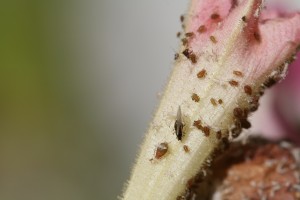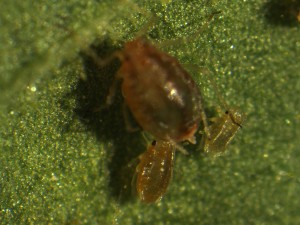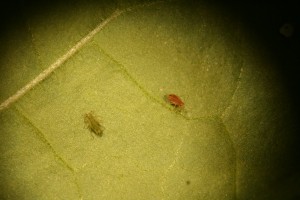Scouting for Green Peach Aphids in Tobacco
go.ncsu.edu/readext?307098
en Español / em Português
El inglés es el idioma de control de esta página. En la medida en que haya algún conflicto entre la traducción al inglés y la traducción, el inglés prevalece.
Al hacer clic en el enlace de traducción se activa un servicio de traducción gratuito para convertir la página al español. Al igual que con cualquier traducción por Internet, la conversión no es sensible al contexto y puede que no traduzca el texto en su significado original. NC State Extension no garantiza la exactitud del texto traducido. Por favor, tenga en cuenta que algunas aplicaciones y/o servicios pueden no funcionar como se espera cuando se traducen.
Português
Inglês é o idioma de controle desta página. Na medida que haja algum conflito entre o texto original em Inglês e a tradução, o Inglês prevalece.
Ao clicar no link de tradução, um serviço gratuito de tradução será ativado para converter a página para o Português. Como em qualquer tradução pela internet, a conversão não é sensivel ao contexto e pode não ocorrer a tradução para o significado orginal. O serviço de Extensão da Carolina do Norte (NC State Extension) não garante a exatidão do texto traduzido. Por favor, observe que algumas funções ou serviços podem não funcionar como esperado após a tradução.
English
English is the controlling language of this page. To the extent there is any conflict between the English text and the translation, English controls.
Clicking on the translation link activates a free translation service to convert the page to Spanish. As with any Internet translation, the conversion is not context-sensitive and may not translate the text to its original meaning. NC State Extension does not guarantee the accuracy of the translated text. Please note that some applications and/or services may not function as expected when translated.
Collapse ▲When to scout for tobacco aphids
Green peach aphids may be present on tobacco plants from roughly 4 weeks after transplant through topping, but they are most common on plants from 6 to 8 weeks after transplant. Following topping, leaves mature and undergo both physical and chemical changes. Mature leaves are no longer attractive, suitable reproductive hosts for aphids, so therefore, aphids are rarely present in tobacco post-topping.
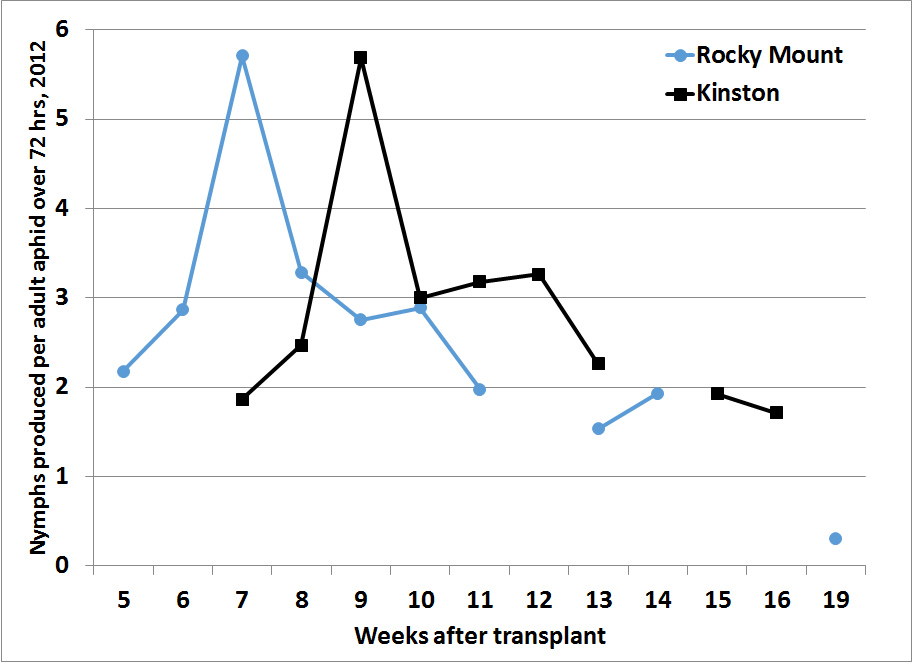
Green peach aphid nymphs produced per female over 72 hrs in laboratory assays conducted with leave collected between 5 to 19 weeks after transplant, 2012. Data via Alejandro Merchan
Aphids may be present on suckers post-topping, but good sucker control is more important than attempting to managing insects on non-harvestable plant parts.
What part of the plant to scout for green peach aphids
Green peach aphids are found on upper stalk and developing leaves. They may also be present on flower heads prior to topping.
Aphids are rarely present on mature, lower stalk leaves. Aphids feed primarily on the underside of leaves.
How to scout for green peach aphids
Carefully observe the undersides of leaves in the upper third of the plant for aphids. You may see dark green or black winged aphids on plants first. Winged aphids colonize plants, after which wingless aphids are produced. Do not include winged aphids in scouting data, as they may or may not establish on plants. Only count wingless, reproducing aphids when scouting. Reproducing female aphids will be surrounded by smaller nymphs.
Shed aphid cuticle, or “skins” may also be present on plants. These cast skins can remain on plants long after aphids have died. Be careful to distinguish between cast skins and live aphids. Also be prepared to identify aphids parasitized by wasps. These aphid “mummies” contain developing wasp larvae and may also be present on plants long after reproducing populations. Aphid mummies are light brown, dull, larger, and rounded as compared to live aphids. They will not move if probed. Neither cast skins or aphid mummies should be included in scouting data.
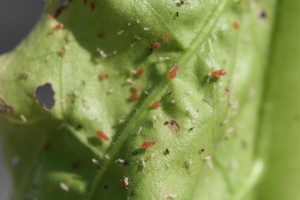
Red colored green peach aphids on the underside of a leaf. Note white cast skins. Photo: Hannah Burrack
Aphids can be red, orange, or green. All three of these color morphs are the same species–“green peach aphids!”
Green colored aphids are commonly earlier in the growing season and may be harder to spot. However, when populations are large, they are quite noticeable.
Green peach aphid threshold
The economic threshold for green peach aphids in tobacco is 10% of plants with 50 or more wingless aphids per leaf before topping. Since aphid populations can multiply quickly, fields with populations below threshold should be scouted more frequently.



